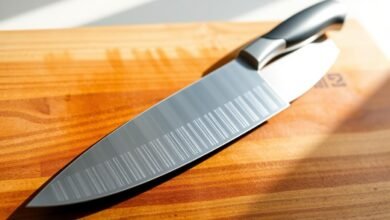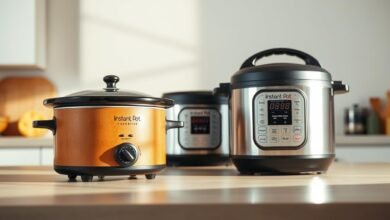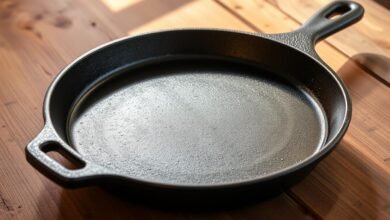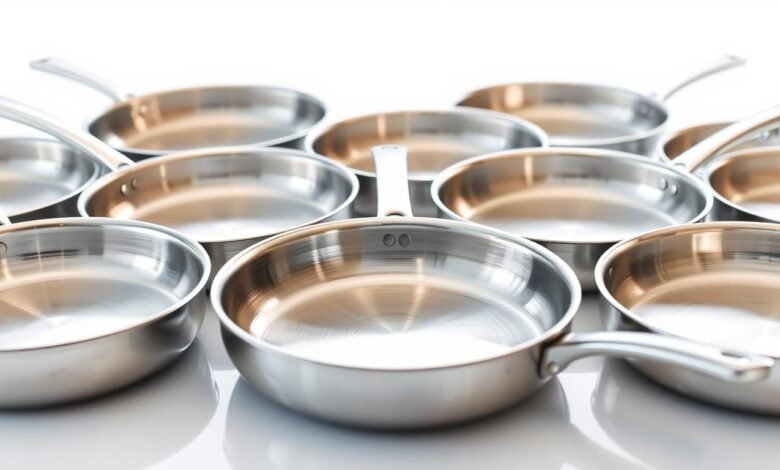
You know that small moment when a favorite pan turns stubborn and you feel a twinge of worry about ruining your cookware. That quiet frustration is familiar in many kitchens. You want clear results, not guesswork.
In this guide you’ll get practical, friendly steps that respect your time and your gear. Baking soda can handle many messes if you scrub a bit more. A targeted product like Bar Keepers Friend saves effort on tough stains and brings back a like-new shine when used briefly and without heat.
You’ll learn safe moves: boil water with baking soda for rising stains, use vinegar for rainbow tint, dry fast to avoid spots, and never wash hot metal right away. New scouring pads and gloves make the job easier and protect the finish.
Key Takeaways
- Use baking soda for routine scuffs; expect more scrubbing.
- Reach for Bar Keepers Friend for heavy stains, use briefly and cool surfaces.
- Boil soda water for side stains; scrub while warm with a long-handled brush.
- Vinegar removes heat tint; dry immediately to prevent water spots.
- Preheat before oil, add salt after water boils, and let cookware cool before washing.
Before You Start: Safety, Supplies, and Prep for Best Results
A little planning stops mistakes and saves time. Lay out your kit and clear the sink so you can work without interruptions. This simple step protects the finish and helps you avoid splashes across the counter.
Gather your supplies — dish soap, baking soda, white vinegar, a soft sponge, a fresh scouring pad, a long-handled brush, a microfiber towel, and gloves. Keep items within reach so you won’t pause mid-task.
Make sure the pan is fully cool before you start. Submerging a hot pan in cold water can warp the metal and ruin the base. Wait a few minutes, then run hot water to loosen grease and stuck food.
- Begin with the gentlest tool: a soft sponge for film and smudges.
- Reserve a new scouring pad for stubborn marks to avoid marring the surface.
- Use a long-handled brush when reaching the sides of a pot or when some heat remains.
- Plan a soak or simmer with hot water and a little soap if food is stuck.
- Set a clean towel out and dry the surface immediately after rinsing to prevent water spots.
Wear gloves when using powdered cleaners and ventilate the kitchen. Avoid harsh chemicals and heavy steel wool unless absolutely necessary, since aggressive abrasion can void warranties.
How to clean stainless steel pans: step-by-step methods that actually work
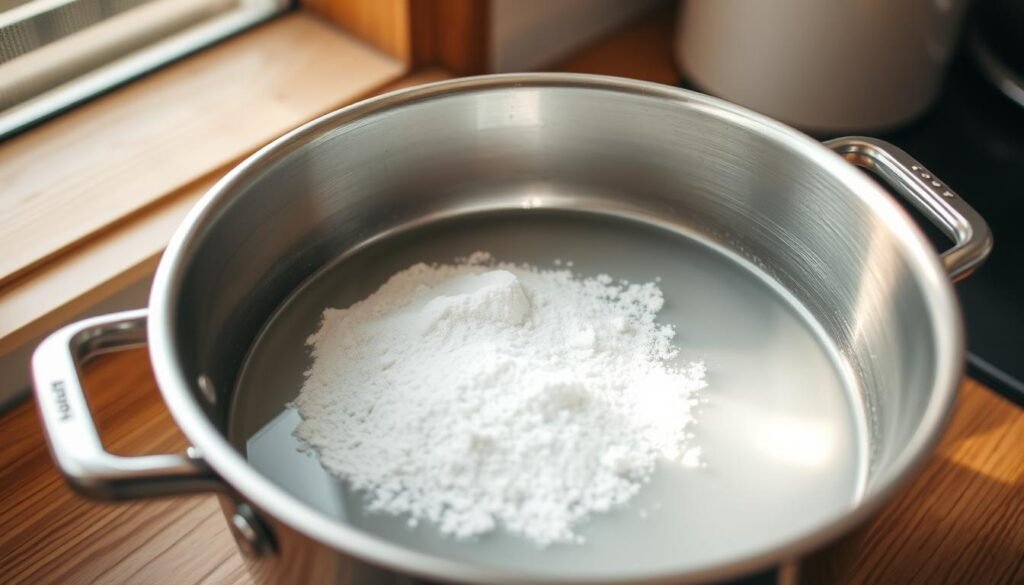
Start with simple steps that remove grease and loose bits without stressing the finish. Begin with the gentlest option and work up only as needed. This protects cookware while saving time.
Begin here:
- Fill the pan with hot water and add a small squeeze of dish soap. Let it sit a few minutes, then lift oil and loose food with a soft sponge.
- For everyday marks, sprinkle baking soda and add a few drops of water to make a spreadable baking soda slurry. Let it sit 3–5 minutes, then scrub with a fresh scouring pad using light, even pressure.
- If residue stays, repeat the slurry and extend dwell time up to 10 minutes. A second pass often removes film without harsher cleaners.
For side stains: mound baking soda in the center, add about 1/4 cup water, and bring to a gentle boil so the baking soda deposits up the walls. Turn off heat and, while the hot pan is still warm, scrub with a long-handled brush or new pad. Keep a towel on the handle for grip.
When you need a like-new shine or face tougher stains, use Bar Keepers Friend as a light paste on cool surfaces, scrub briefly (about a minute), then wipe and rinse. Finish with a hot water rinse and dry with a towel to reveal any final touch-ups.
Troubleshooting Specific Problems on Stainless Steel Cookware
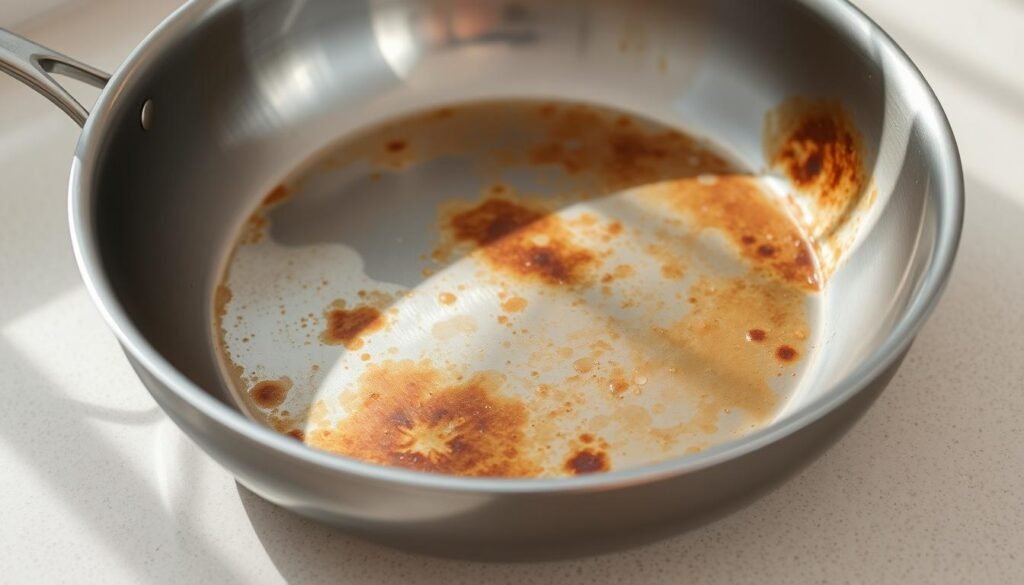
Tackle common cookware problems with simple, stepwise fixes that save time and protect your finish.
Stuck-on bits of food: Scrape away any loose debris first. Fill the pan with hot water and a drop of dish soap or a couple spoons of baking soda. Bring the water toward a boil, then reduce to a simmer for a few minutes.
While the pan is warm, use a wooden spoon to release softened bits food without gouging the surface. Finish with a long-handled brush or a fresh scouring pad, rinse, and dry with a towel.
Rainbow tint, mineral rings, and burnt film
Rainbow discoloration: Swirl diluted white vinegar across the surface and wipe with a soft sponge. Rinse and dry to restore clarity.
Chalky white mineral spots: Bring a 1:3 vinegar-to-water solution to a boil in the pot. Let it cool, then wash and dry immediately to prevent new deposits.
Burnt or burnished areas: Try Bar Keepers Friend paste or a baking soda paste with a little water. Scrub with elbow grease and a scouring pad, or boil water with a splash of vinegar, remove from heat, add baking soda, let fizz, then scrub.
Exterior refresh: Wet the outside with hot water, dust baking soda, rest 10–20 minutes (longer for tougher stains), squeeze lemon over the area, and scour with a copper cloth or pot brush. Rinse and give a final wash and dry.
- Work with targeted warmth—keep the pan hot enough to help release residues, but avoid overheating.
- Repeat the effective step once rather than mixing aggressive methods at once.
- Always rinse residues thoroughly and dry each surface with a clean towel to check for faint streaks.
| Problem | Likely Cause | Quick Fix | Notes |
|---|---|---|---|
| Stuck-on food | Dried food and grease | Soapy water or baking soda water; bring to a boil, simmer, scrape with wooden spoon | Finish with brush or scouring pad; dry immediately |
| Rainbow discoloration | Overheating | Swipe with diluted vinegar and wipe with sponge | BKF can remove lingering tint |
| Mineral spots | Hard water deposits | Boil 1:3 vinegar-water, cool, wash and dry | Dry promptly to avoid recurrence |
| Burnt film / burnished surface | High heat and baked-on residue | BKF paste or baking soda paste; scrub with elbow grease | For heavy spots, fizzing vinegar + baking soda helps lift residue |
Pro Care Habits to Prevent Sticking, Stains, and Warping
Simple preheat rituals and quick drying make a big difference in how your pans perform long term.
Preheat, then add oil: Heat the pan over medium to medium-high until a tiny droplet beads and skitters (the Leidenfrost test). Add oil and wait for a clear shimmer. Only add food once the oil shimmers for near nonstick results.
Avoid blasting high heat—stainless retains heat and can overcook or warp. Use steady heat to limit hotspots and preserve the finish.
- Salt water only after it reaches a rolling boil to prevent pitting on stainless surfaces.
- Let the pan cool fully before washing; rapid temperature shifts can warp metal.
- Dry immediately after rinsing with a soft towel to prevent water spots and mineral rings.
Small daily steps pay off: Wipe away thin films after cooking, clean gently each use, and store pots pans with padding. A simple routine—preheat, oil, cook, cool, wash, dry—keeps stainless steel cookware working well and reduces heavy scrubbing later.
| Habit | Why it matters | Quick action |
|---|---|---|
| Preheat then oil | Reduces sticking and builds even sear | Heat until water beads, add oil, wait for shimmer |
| Salt after boiling | Prevents pitting corrosion | Add salt once water is at a rolling boil |
| Cool before washing | Prevents warping from thermal shock | Allow natural cool-down, then wash |
| Dry immediately | Avoids water spots and mineral buildup | Wipe with soft towel right after rinse |
Tools, Cleaners, and What to Avoid for Stainless Steel Pans
A small kit of gentle tools and trusted cleaners keeps your pots and pan performing well.
Use non-abrasive sponges and quality scouring pads for best results
Start soft. Use a soft sponge first for film and light residue. A quality scouring pad handles clingy bits without over-etching the surface.
Keep a sturdy brush for rims and a fresh pad for stubborn spots. Match the tool to the job so you limit elbow grease and protect the finish.
When steel wool is mentioned—and why it can void warranties
Very fine steel wool may lift burned film, but it often leaves micro-scratches. Those marks can void warranties on stainless steel cookware.
Reserve steel wool as a last-resort, then test on an inconspicuous area and use very light pressure.
Community-approved cleaners and polish options
Bar Keepers Friend, Ajax powder, S.O.S. pads, and Chore Boy scrubbers are widely used for spot treatment. Apply BKF briefly on a cool pan and wipe off within a minute.
Copper cloths and Hagerty or Mauviel Inobrill shine exteriors with less risk than aggressive steel. Avoid bleach and oven cleaners—they can pit or discolor stainless steel pots and steel pots.
- Soft sponge for films
- Scouring pad for clingy residue
- Copper cloth or polish for exterior touch-ups
Conclusion
Finish strong: use a small, steady kit and simple steps to protect finishes and save time. Start gentle with hot water and soap, then use a baking soda slurry when marks persist.
When stains climb the walls, bring water and baking soda briefly to a boil, then scrub for a few minutes. For mineral rings or rainbow tints, boil a 1:3 vinegar-and-water mix and rinse, then dry immediately.
Reserve Bar Keepers Friend for a cool surface and a short application. Preheat before oiling, add salt only after water is boiling, let cookware cool before washing, and dry right away.
Keep a short checklist at the sink, choose the right tools, and escalate steps in order. With these steady habits, your stainless steel cookware and pots pans will deliver reliable results and long life.
